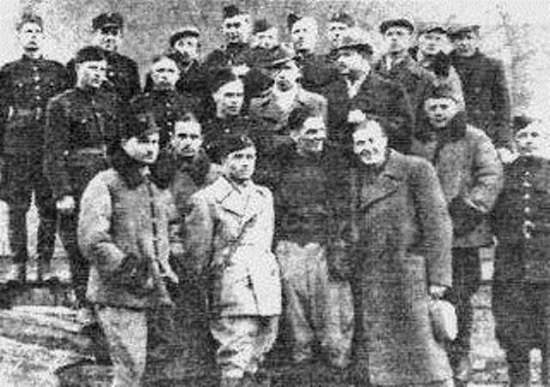CARPATHIAN UKRAINE SECRET: BUNKER OF THE ARPAD LINE
The World War II ended 71 years ago, but it’s horrible memories and even physical findings, and Ukrainian are still in the woods, steppes, rivers and lakes. But the attractions of this carnage mid-20th century. were and still are-long fortifications, including isolated famous French Maginot Line, the German Siegfried Line and the Atlantic Wall, Finnish Mannerheim Line and Salpa Line, famous Soviet Stalin Line. We'll talk about a little known defensive line in the Ukrainian Carpathians – Árpád line (hung. Árpád-vonal).
Since 1920's all civilized countries in Europe hysterically dug into the ground. Almost the entire continent was built numerous military fortifications, including strongholds, pillboxes, opened fire lines, trenches, rifle trenches, antitank pyramid – concrete barrages, minefields, concrete building... This active process of increasing military power and security are not passed over and Carpathian ranges. But before you begin the story of the Carpathian line of defense as known Árpád line, we would like to address the causes of its construction.
Based on the decisions Saint-Germaine peace treaty in 1919 and the Trianon peace treaty in 1920 Carpathian Ukraine (Zakarpattia or Transcarpathia) became part of Czechoslovakia on the rights of autonomy. But the real autonomous status Carpathian Ukraine, provided contracts and has not been provided with the Czechoslovak government. After the Munich agreement of four countries (Germany, Italy, France and the UK), which was signed on September 30th 1938, the Czechoslovak government was powerless to resist the offensive of the German and Hungarian aggression, therefore, agree to Slovakia and Carpathian Ukraine the status of an autonomous republic. Then it was worse – according to the decision of the 1st Vienna Award of November 2, 1938 a significant part of the Carpathian Ukraine (namely Uzhgorod, Mukachevo and Sevliush counties) cities of Uzhgorod, Mukachevo and Berehovo were annexed to Hungary. Under these conditions, the capital of Carpathian Ukraine moved to Khust. To protect the state independence and the fight against terrorism Hungarian formations were created armed forces of Carpathian Ukraine – the Defense Organization “Carpathian Sich”, a great help in the creation of which provided the Organization of Ukrainian Nationalists.
For several months, March 15, 1939 the Soim – parliament Carpathian Ukraine proclaimed a full state independence, and the president was elected Avgustine Voloshin, who after independence immediately sent a telegram personally to Adolf Hitler asking for recognition of the Carpathian Ukraine and taking her under the protection of German 3rd Reich and to prevent its capture by Hungary. But the German consul in Khust advised Ukrainian troops not to resist the Hungarian invasion... On the night of 13 to 14 March 1939 Budapest, with the support of Berlin launched, start a war against the Carpathian Ukraine. And March 16, 1939 after suffering heavy losses, the enemy was able to capture Khust, and March 18 of that year, a large part of the Carpatho-Ukraine was occupied by the Hungarian invasion troops. At the end of March 1939 the president of the republic Avgustin Voloshin and the Government went through Romania to emigrate to the West.
Occupied Carpatho-Ukraine new Hungarian government immediately began to establish their own order because thought that settled here permanently. Since the beginning of the German-Soviet war in August 1941 Hungary immediately took part in the attack on the USSR. However, the Hungarian rulers urged the regent Miklós Horthy in Budapest necessity to join the war against the red Moscow to prevent territorial disputes over Transylvania in favor of Bucharest. Hungary declared war on the USSR June 27, 1941 and on 1 July of that year at the direction of Hungarian Carpathian troops attacked a group of 12th Soviet army in Carpathians. In addition, Hungarians took part in the battle of Stalingrad, but soon after spring 1943 the 2nd Hungarian army, which helped to Generalfeldmarschall Friedrich Paulus, almost ceased to exist as a military unit – a breakthrough of Soviet forces across the river Don passed directly through the Hungarian troops.
Having been defeated in the battle of Stalingrad, the Hungarian military elite began to think about her own line of defense that would protect the country against a possible Soviet invasion. It was the so-called Árpád line, after the first Hungarian prince Árpád, who in 889 united Hungarian tribes and founded the Hungarian state in Pannonia. Hungarian army for 3 years (from 1940 to 1943) built in the Carpathian Ukraine very powerful fortifications (to pass Duklia to the village Kolochava), but they were not ready for a long time to defend the eastern border and to keep a possible Soviet offensive because the orders Miklós Horthy in January 1944 Árpád line was completed and strengthened.
Military defense system being pulled along the old Hungarian-Polish border, which stretches through the Carpathian mountain range longer than 600 km. In the construction involved prisoners (mainly Serbs), the local population (Ukrainians) and other employees. The work was hard. While in the Eastern Carpathians defense held Army Group under the command of German Colonel General Gotthard Heinrici (1st German Panzer Army and 1st Hungarian Army), in which there were 320 thousand soldiers and officers, 2500 guns and mortars, 25 tanks. The Árpád line defense system comprised 99 defensive points 760 and 440 reinforced wooden and earthen structures, 440 fire areas, 400 km of trenches and rifle trenches.
Unlike similar plants in Finland and France, Árpád line was solid and consisted of separate units of defense. Extreme elements: the Duklia pass in the west and the east Yablunytskyi pass. Hungarian challenge for the military was to build an effective line of defense with minimal cost in the shortest possible time. The main and most powerful line of fortifications was built is in Ukrainian Carpathians – in Uzhgorod (line of Hunyadi), Mukachevo (line of St. Laszlo) Khust (central Árpád line – the line of St. István) and Yasinia (line of Prince Eugene of Savoy) directions. Most units Árpád defense line built in river valleys. These lines closed the main passes in the Carpathians and the valleys of the rivers Uzh, Latorytsia and Tysa.
Meanwhile, the Eastern Front and Soviet forces are increasingly approaching the borders of Hungary. As a result of Lviv-Sandomir operation, Soviet troops occupied Western Ukraine and part of Poland. In September 1944, Soviet troops crossed the Hungarian border. October 15, 1944 Miklós Horthy announced the conclusion of a truce with the USSR, but the Hungarian troops stopped warfare. September 8, 1944 began the battle of the Duklia pass – strategic offensive forces of the 1st and 4th Ukrainian Fronts in the Eastern Carpathians, which ended October 28, 1944 the total number of troops advancing Red Army was 246,000 people, it was opposed by a united group of Army of German Colonel General Gotthard Heinrici – only about 300 thousand people. Árpád defense line within the Eastern Carpathian military operations commanded directly the German Colonel General Gotthard Heinrici. On the defensive line only within the 4th Ukrainian Front offensive was built 99 bases, pillboxes 759, 439 open fire lines, 400 km of trenches and rifle trenches, 135 km of anti-tank facilities. But the military elite Red Army was aware of the bad defense system in the region, and selecting the right tactical move, advancing in other areas where there were large concentrations of pillboxes.
For October 20, 1944 troops of the 4th Ukrainian front under the old Czechoslovak border: October 24, they had seized the town Khust, October 26 – Mukachevo, October 27 – Uzhgorod, October 28 – Chop. Thus October 28, 1944 ended with the Soviet “liberation” of Ukraine from Nazi-occupation, which replaced the Kremlin. As a result of the battle of the Duklia pass, the Soviet troops, breaking through the fortification line Árpád, crossed the Carpathians, occupied the Carpathian Ukraine and created conditions for further progress in Czechoslovakia and Hungary.
Interesting is the fact that in most locations pillboxes of Árpád line and there were no battle, namely the Mukachevo and Khust directions. The military leadership of the Red Army was aware of the bad defense system in the region, and acted in other directions. So all remaining mined fortifications and bunkers, most tourists can be seen in its original form. Now this unique exhibit of World War II. The most popular among objects Árpád line is the area of the village Upper Hrabivnytsia where the 1.5-kilometer tunnel with lateral deviations. It was stored ammunition and weapons were located control exits, ventilation shafts. It was the military, which were all made to keep long defense.
Several years ago, this writer visited Khust direction of Árpád line, saw tunnels and pillboxes of military defense facility. It is a small network of tunnels inside the mountain. The purpose of this facility is still not known for certain. Tunnels in bunkers Árpád line – from very narrow to very wide – then go straight up and down, are rare exits to the surface. Outputs are different – vertical and inclined. Outputs also strengthened, most likely a former pillboxes, connected to the main hopper. All pillboxes now destroyed, locals talk about blown up after the war pillboxes strongest units of the KGB, where Hungarian soldiers were tortured Ukrainian who did not want to defend Árpád line. Rooms such as separated and insulated doors, inside a little large tunnel like passage room. Rural residents fear that this object can be mined premises to the present time. Each of the bins Árpád line has three floors, which are currently available for review and study. There are objects completely destroyed, the Soviet government made of some redecorating. Some items are not certified, others – looted during the Soviet era, are objects that have been classified, there are places of mass execution of Jews living in Transcarpathia.
Being a long time in the bunkers and tunnels Arpad line cannot but help the wounded and prepare him for evacuation – is possible. Segment of Khust area near the village Synevyr a few hundred pillboxes, which are not interconnected, but some can go. Near Mount Tereblia is multi-command post. There is still kept pace Shuttle, hospital room and artillery caponier. After seeing the walls inside, you can see a few places-like walled passages. In short, the space for historical and archaeological research is, would be only the money...
Arpad unique defensive line, which got to Ukrainians in Transcarpathia since the World War II, has become a tourist highlight of the region. Military equipment of different times and more people. More than three thousand pieces of weapons, equipment, ammunition and medical instruments collected Transcarpathian enthusiasts. Therefore, all travelers a variety of interesting and mysterious places of Ukraine recommend come on line and Árpád personally inspect military facilities Hungarians during the World War II. We wish you interesting experience, go to Transcarpathia!
by Denis KOVALIOV, source bandera.lviv.ua










Коментарі
Дописати коментар